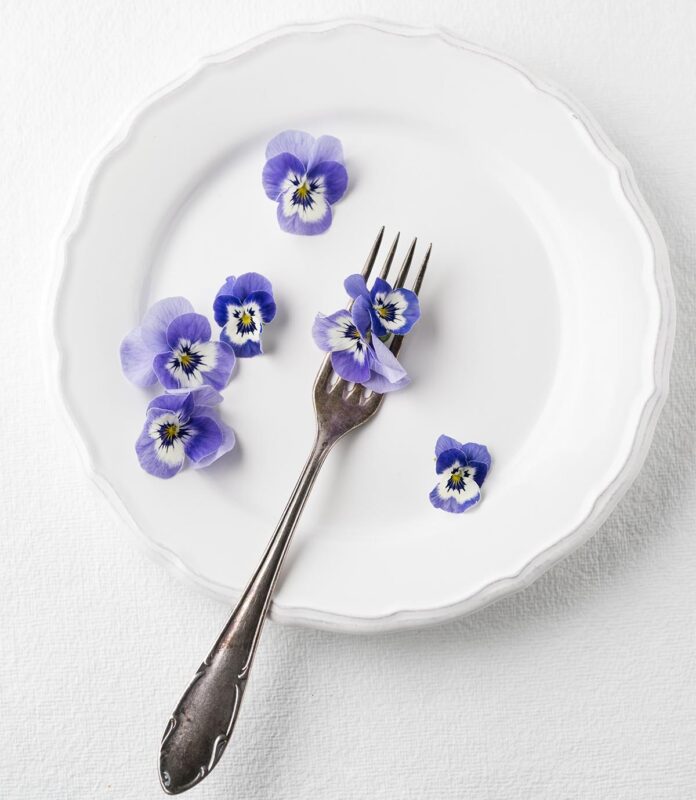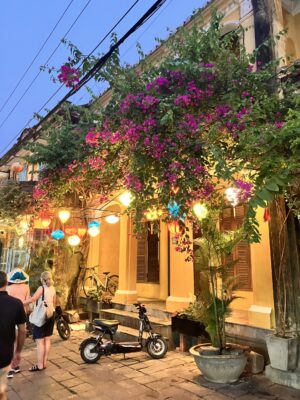
DP BOOKS
An Appetite for Blooms
Why flowers are delicious—but lotus eaters give flower gourmands a bad name.
I’ve been eating flowers for as long as I can remember. I don’t recall who taught me that violets and wood sorrel were edible, but I can picture myself, barefoot on my childhood lawn in Massachusetts, picking dog violets from the place where the woods met the grass, and popping them into my mouth. I remember collecting big bunches of them, handfuls of purple, fragrant little flowers, their stems juicy like pea shoots.
A forager friend once showed me her trick for entertaining guests—she likes to roll a log of goat cheese in nocturnum, dandelion, and marigold petals collected from her backyard and serve it on a piece of cabbage with crackers. I’ve adopted this practice as my own. Like her, I also eat daylily buds before they open, throwing them into stir fries or adding them to soup.
While it hasn’t quite caught on with the masses, there is a name for people like me: we’re called lotus-eaters or lotophagi. The nickname was popularized by The Odyssey, which was translated to English for the first time in the early 17th century, and not long after, the phrase “lotus-eaters” started popping up in the works of poets and playwrights.
In this story, the hero’s ship has been blown off course by some rogue, god-sent winds, and he has to drop anchor on a pretty little island, covered with greenery and laden with fresh fruit and water. The island is also home to a group of natives who don’t do much except eat flowers and fruit and bask in the sun.
Odysseus discovers that the natives have shared their delicious botanical sustenance with his men, and that it’s making them a little too mellow. They’ve forgotten their lives and duties.
Calling someone a “lotus-eater” is never a compliment. Poets and authors, including Dr Alfred, Lord Tennyson, W. Somerset Maugham, and James Joyce, drew inspiration from the episode of the lotus-eaters, as did a number of musicians and filmmakers. While the works differ greatly, their message is the same: lotus-eaters aren’t to be emulated, even if you might be tempted by their relaxed lifestyle.
While the moniker appears more often in fiction referring to drug-addled foreigners than to actual petal-crunchers, its very existence speaks to the tendency to censor, eroticize, and exoticize non-white cultures and their practices. And while it’s unlikely the actual flower described in Homer’s epic was a lotus, I think it’s significant that English-speakers chose to assign such negative connotations to a flower that is held sacred in many non-white cultures. “Of all the flowers that have inflamed human societies, the lotus has to come first,” writes horticultural historian Jennifer Potter in Seven Flowers: And How They Shaped Our World.
Blue lotus was central in the creation myths and burial rites of ancient Egyptian peoples. In Southeast Asia, it was the pink-tinged “sacred lotus” that captured the minds of storytellers and artists. Compared to the spiky, elongated petals of the blue lotus, the sacred lotus is a round, blushy, soft-looking thing with a yolk-bright yellow center. It has a distinctive paddle-shaped seed head that contains edible, nutrient-rich seeds (also known as lotus nuts) inside its unevenly spaced holes.
Sacred lotuses are native to the warmer regions of Asia, but these days it can be found all over the world, from Australia to Russia to South America. Its image is just as widespread, and once you start looking for a lotus, you’ll spot them everywhere (particularly if you practice yoga or frequent your local vegetarian restaurants). But before they were adopted as shorthand by hippies and wellness types, lotuses were used by artists to convey devotion.
As the name might suggest, English-speakers have long known that the sacred lotus plays an important role in the cuisine, mythology, art, and religion of many cultures. As a lapsed Catholic, I can’t help but compare the lotus to the cross. I used to wear a small gold crucifix necklace everywhere I went, because those simple lines were a reminder that I loved my religion. To me, the cross meant faith, protection, and striving toward goodness. Wearing the necklace was a way to reconnect with my values. Although the iconography is very different, the lotus shape that appears so often in Buddhist and Hindu art and adornment seems to fulfill a similar function for many people. To see a lotus is to be reminded of the potential for goodness, the possibility of transcendence, the hope for growth.
I do understand why flower-eating feels like such a rich metaphor, but it’s also something people do every single day, all around the globe, often without even thinking about it. Alongside being quite plainly disparaging, this metaphor also reveals an ugly tendency to denigrate those of us who love beauty so much we just want to consume it, from stem to stamen.
Excerpted from The Ugly History of Beautiful Things: Essays on Desire and Consumption by Katy Kelleher. Copyright © 2023 by Kathryn Kelleher. Reprinted by permission of Simon & Schuster, Inc.
Hero image by Westend61 via Getty Image




